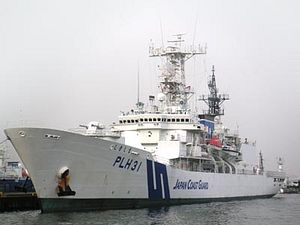The Chinese-language newspaper Beijing Daily reported this week that China Shipbuilding Industry Corporation (CSIC) has signed contracts to build a 10,000 ton marine surveillance ship, which would be the largest such vessel in the world. The ship will be built by the CSIC’s “704 Research Institute,” along with another 4,000 ton vessel. English language sites Global Times and South China Morning Post also picked up on the story.
Notably, the current owner of the world’s largest marine surveillance ship is Japan, China’s rival in a bitter territorial dispute over the Diaoyu/Senkaku Islands. Japan’s Shikishima, which was commissioned in 1992, displaces 7,175 tons. Japan recently added a second Shikishima-class patrol ship, dubbed Akitsushima, which launched in July 2012 and was officially commissioned in November 2013. According to Navy Recognition, both ships are 150 meters long and are equipped with Oerlikon 35 mm twin cannons and two M61 Vulcan cannons, with the latter being used as part of a remote weapons system.
China’s new marine surveillance ship is one more piece of the tit-for-tat escalation in the East China Sea. As of now, China’s largest surveillance vessel, the Haijian-50 (“haijian” literally meaning “marine surveillance”), displaces around 4,000 tons. The new marine surveillance vessel would dwarf that, while also responding to Japan’s recent construction of a new Shikishima-class ship. Given that the Haijian-50 is often assigned to patrol the East China Sea, we can assume the new 10,000 ton ship will be patrolling the same waters. Still, there’s no detail yet as to what sort of weaponry will be outfitted aboard the new Chinese patrol ships.
The plans for a new maritime surveillance vessel are part of larger build up of China’s fleet. Back in 2012, Xinhua reported that China was planning to add 36 patrol vessels to the China Marine Surveillance fleet by mid-2014. In the period from 1999 to 2011, according to Xinhua, China added 13 new 1,000 ton patrol ships and five helicopters to the same fleet.
The building of a new maritime surveillance ship will receive less attention than the reports that China is constructing a second aircraft carrier, but the patrol vessel might be more important in the long run. China’s endgame for the disputed regions in the South China Sea and East China Sea relies less on the PLA Navy than on China Marine Surveillance (CMS), a law enforcement agency under the State Ocean Administration. Deploying maritime surveillance ships allows China to exercise control in these regions without officially crossing the line into militarism. For example, the new Hainan fishing regulations, which caused an uproar by requiring foreign vessels to seek permission to fish in a huge swatch of the South China Sea, will likely be enforced by CMS, not the navy. The more vessels CMS has to work with, the more efficiently China can implement its strategy.
My colleague Zachary Keck wrote, in the context of East China Sea Air Defense Identification Zone, about China “waging lawfare” — exerting control of disputed regions by increasing its de facto control. Maritime patrols are a major part of this effort, and the new ship will increase China’s surveillance capabilities. Whether the new ship is deployed in the East China Sea or the South China Sea, it will provide both a psychological and a tactical boost to China’s maritime patrols.

































